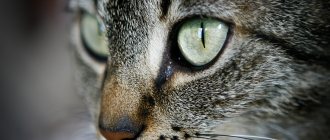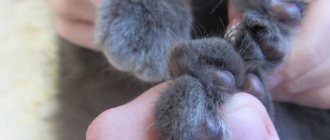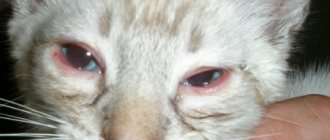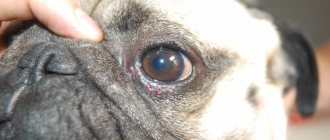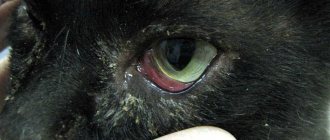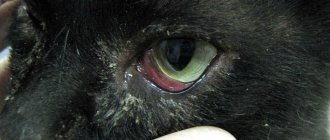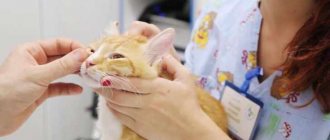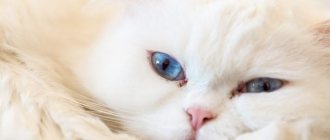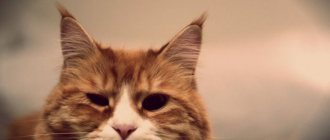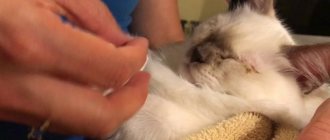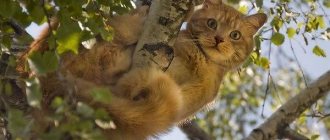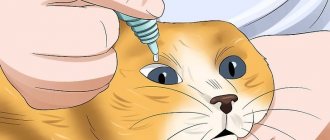Vestigial organ or not
The inner eyelid is also called blinking and is perceived by some as an atavism (similar to the appendix in humans). Almost all animals have this organ.
Having developed at the beginning of evolution, the eyelid still continues to perform its functions, so it cannot be called rudimentary. But a century ago, experts considered the organ useless and recommended its removal: supposedly, the film prevents the animal from seeing better.
Modern biologists do not agree with this statement.
They are sure that the cat’s inner eyelid is in demand and perfectly fulfills its purpose, i.e. is an active organ, not a rudiment.
Structure of education
Once upon a time, humans also had a blinking eyelid. Now all that remains of him is a memory in the form of small bumps in the corners of his eyes. In animals, the structure of the organ has not changed and is a complex “construction”.
The eyelid is impressive in size, but most of it is hidden in the eye socket. In a awake cat, only a small section of the membrane in the shape of a crescent can be seen.
Essentially this is a fold of the conjunctiva located in the medial corner of the eyeball.
When it opens, the membrane covers the cornea on one side, and the inner surface of the upper and lower eyelids on the other.
The nictitating membrane is held in place by a special T-shaped cartilage (or rather, its horizontal bar). The vertical “leg” is girded by a system of glands that produce tears.
On the bulbar surface (in the area of the sclera) there are follicles that act as lymphoid nodes. All components are connected into one operating mechanism called the third eyelid.
Functions of the eye membrane
The secretion secreted by the cartilage glands washes the cornea, providing lubrication to the moving eyelid. The membrane is large enough to completely cover the cornea.
It was not by chance that nature endowed ancient animals with an organ.
Predators (which include cats) were forced to hunt, making their way through forest thickets, fight with “competitors”, defending their prey, and therefore the eyes needed reliable protection
Domestic cats remain predators by nature, and the internal membrane continues to fulfill its “duties.”
| Name | Meaning |
| Protective | In combination with the outer eyelids, protects the eyes from damage |
| Cleansing | During the blinking process, it removes small particles that fall on the cornea |
| Moisturizing | Transports tear fluid across the cornea, preventing it from drying out |
| Immune | Lymphoid nodules produce immunoglubogulin secretion, which provides protection against infections |
The membrane comes into play when the cat's eyes close.
The fold, straightening, moves from the inner corner to the outer. On its way, it sweeps away all small debris and evenly distributes the tear over the entire surface of the eye.
Why does a cat need a third eyelid?
The thin, almost invisible film in the inner corner of a cat's eye is called the third eyelid or nictitating membrane. When you blink or tilt your head, it stretches, covering the cornea, and then quickly returns to its original position.
You can understand why a cat needs a third eyelid by familiarizing itself with its functions.
- Participation in the synthesis of tear fluid.
- Wetting the surface of the cornea, removing dust and small mechanical particles from it.
- Protecting the eyeball from damage.
- Detention and neutralization of pathogenic microorganisms.
Dysfunction of this organ causes severe discomfort to the animal, as the cornea constantly dries out and becomes inflamed. In advanced cases, this leads to blindness.
Third eyelid prolapse: causes
When the animal falls asleep, the muscles relax and the membrane partially covers the eye.
But if the cat does not try to fall asleep, and the film captures part of the cornea, they speak of organ prolapse.
Why is this happening
| Factor | Peculiarities |
| Injury | Usually occurs in a fight, or when a cat crawls through the jungle, runs into sharp objects, and falls unsuccessfully. Prolapse occurs when part of the membrane is torn off or cartilage is damaged. |
| Foreign body | Small litter and dust particles are not a hindrance to formation. But if a larger object gets into the eye, it can damage both the cornea and the membrane. |
| Eye diseases | Conjunctivitis, uveitis, keratitis, erosion and other ophthalmic problems irritate the eyes, making the cat want to scratch them. Education is also connected here, the animal involuntarily blinks (to remove the stimulus) |
| Parasites | Worms travel throughout the body and can also lodge in the tissues of the eyelids, injuring them. In animals weakened by diseases, fleas can be seen in the corners of the eyes, which often cause damage to the membrane and the development of infections. |
| Adenoma | The factor is rare in cats (usually in exotic breeds). But if the growth is localized on the eyelid, it will prevent the membrane from folding normally |
| Internal illnesses | Colds, digestive problems, and malfunction of vital organs weaken the pet. Internal pathologies can lead to inflammation of the mucous membrane of the eyes, conjunctiva, and cause weakening of the muscles that hold the fold together. |
| Cartilage crease | Eversion is observed with pathological abnormalities in eye development. The cartilage becomes distorted and causes the membrane to protrude outward |
| Prolapse | Refers to the membrane's own diseases and is more often observed in bracephalous breeds (with a flattened muzzle). The growth of the skull does not keep pace with the enlargement of the eyes, resulting in a rupture of the ligament holding the membrane |
Not only the smooth muscles of the eyes are responsible for moving the inner eyelid. Movement is regulated by the sympathetic nervous system.
Some medications used in the treatment of internal and eye diseases can inhibit impulses sent to the third eyelid.
Skull injuries and inflammation of the meninges lead to system failure.
One of the reasons is the stress suffered by the cat during surgery for castration, sterilization, etc.
Anesthesia temporarily inhibits all reactions. When the animal moves away from him, the half of the eye remains covered with a bluish eyelid.
Causes of eyelid loss
The nictitating membrane (nictitating eyelid), which in some cases forms the third eyelid, is normally necessary for high-quality cleansing of the surface of the eye. A veterinarian, to whom the cat should be shown, will be able to determine exactly the reason why the membrane has prolapsed and the third eyelid has formed.
© shutterstock
Most often, the appearance of the problem (third eyelid) is caused by the following factors:
- Viral, bacterial or fungal eye infection - if the cat is infected, prolapse of the third eyelid is one eye symptom among a number of other manifestations of a disease that has already taken over the entire body;
- Disease of organs and systems - prolapse of the nictitating membrane is observed as a symptom of a disease or after treatment with very strong antibiotics, which the animal had difficulty withstanding;
- Inflammation of the ears - with pathology, a disturbance in the functioning of the visual system occurs, which is why a third eyelid appears. If treatment is not started, there is a high risk that the cat will lose vision;
- Malfunctions in the functioning of the central nervous system (CNS) - in this case, the transmission of nerve impulses in the animal is disrupted, which is why, after cleaning the eye, the nictitating membrane does not return to its place and remains extended;
- Helminthic lesions and fleas are a general deterioration of the condition and intoxication of the body, which torments the cat, disrupts the functioning of the visual apparatus and the third eyelid falls out;
- Injuries (damaged third eyelid) – the defect in this case is one-sided. It manifests itself from the side of damage;
- Foreign body - if debris that gets into the eye is not removed quickly, then inflammation of the cornea begins, which leads to the third eyelid falling out. Also, the cat at this time suffers from profuse lacrimation;
- Conjunctivitis - appears for many reasons and even allergic ones;
- Adenoma of the third century;
- Atrophic processes in the eyeball;
- Genetic predisposition to the disease, which is especially noticeable in Persian cats;
- Sudden weight loss in the cat. With such a violation, a failure occurs in all processes in the body;
- Eversion of the base of the eyelids (cartilaginous);
- Weakness of the ligaments responsible for the movement of the third eyelid. The treatment is complicated.
It is important to immediately, without delay, carry out therapy to prevent progression of the disease. If the disease is neglected, treatment is seriously delayed and does not always lead to a complete recovery of the animal.
Characteristic symptoms
If the eyelid comes out and covers part of the cornea even in a waking cat, you need to carefully observe the pet to determine other signs of loss of the protective film.
Associated symptoms are:
formations in the corners of the eyes have taken on a significant volume;- profuse lacrimation;
- the appearance of mucous or purulent discharge.
Eyelid loss in both eyes may be accompanied by blepharospasm . The pathology is manifested by involuntary contractions of the circular muscles, causing spasmodic closure of the upper and lower eyelids.
What is third eyelid adenoma in cats?
Despite the fact that the described pathology is not common, owners need to know what third eyelid adenoma is in cats in order to pay attention to warning signs in time.
The disease is manifested by the formation of a benign tumor in the inner corner of the eye. It usually develops in older pets, but can occur in young animals after injury or an infectious disease.
The neoplasm in appearance resembles a bean fruit with a clearly defined network of small blood capillaries. Initially, it has a pale pink color, but the development of the inflammatory process quickly leads to redness and an increase in volume.
Important! Only a veterinarian can make an accurate diagnosis after performing a biopsy and obtaining laboratory test results.
Diagnosis of pathology
Only a specialist in a clinical setting can make an accurate diagnosis and identify the cause. Therefore, if a bluish spot appears on the eye and animal, the pet must be urgently taken to the veterinarian.
A comprehensive examination includes:
taking anamnesis (according to the owner);- visual inspection;
- blood tests (general and detailed);
- biomaterial from the conjunctiva;
- hardware studies - CT (MRI), ultrasound.
Specialized ophthalmological diagnostics are also required. During the examination, the pet's intraocular pressure is measured and examined using optics. Staining the pupil with fluorescein allows you to study the condition of the cornea.
Diagnosis when an eyelid has fallen out
When diagnosing a disease, its cause must be identified, since otherwise the treatment will not be effective enough. The problem can rarely be identified after a visual inspection alone. Most often, to accurately assess the condition, the cat must undergo a comprehensive examination.
© shutterstock
After receiving the results, the necessary treatment is selected for the animal. Required for diagnosis :
- general blood analysis;
- blood biochemistry;
- Ultrasound of internal organs;
- flushing from the mucous membrane of the eye;
- PCR diagnostics.
Taking an anamnesis is also of great importance, as it allows the specialist to better determine the cat’s condition.
Treatment of abnormalities
Self-therapy for this pathology is excluded. You cannot reset a prolapsed membrane at home.
The pet will have to be treated in a hospital setting. The veterinarian decides which method to choose (passive or operative).
Drug treatment
The course of therapy is selected based on the cause that provoked the pathology.
Usually prescribed:
- drugs for healing an injured eye;
- antibacterial drops and ointments;
- antihistamines (for allergic conjunctivitis);
- hygiene lotions.
At the same time, they treat internal diseases and fight parasites.
Weakened animals are prescribed vitamin preparations. In some cases, hormonal therapy is resorted to.
Surgical intervention
Surgery is required in rare cases when a cat begins to have vision problems due to a protruding eyelid. This is usually observed during the formation of an adenoma.
Eversion is also surgically eliminated (cartilage damage cannot be treated with conventional medications).
Do folk remedies help?
Homemade recipes will not help with eyelid loss. But you can use herbal decoctions to wash the eyes if the cause of the formation is associated with inflammation of the conjunctiva.
Preventive measures
Cats with bulging eyes are more susceptible to hair loss. But representatives of other breeds should also be given no less attention to avoid problems.
Prevention includes:
periodic visits to the veterinarian for the purpose of timely detection of diseases;- regular deworming of your pet;
- compliance with vaccination schedules;
- treatment for ticks and fleas.
A balanced diet supports your pet's immune system. Limiting contact with stray animals helps avoid injury and infection.
Causes of development of third eyelid adenoma in cats
A genetic predisposition to the development of this disease is observed in Persians and British, but the pathology also occurs in representatives of other breeds.
No single cause for the development of third eyelid adenoma in cats has been identified. Quite often it is a secondary pathology of the following diseases:
- conjunctivitis;
- viral rhinotracheitis;
- dysfunction of the endocrine glands;
- allergies;
- eye injuries;
- inflammation of the lacrimal glands;
- fungal, viral and bacterial infections;
- helminthic infestations (telasiosis).
